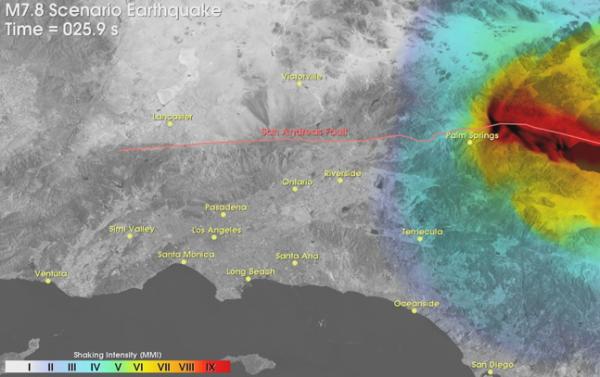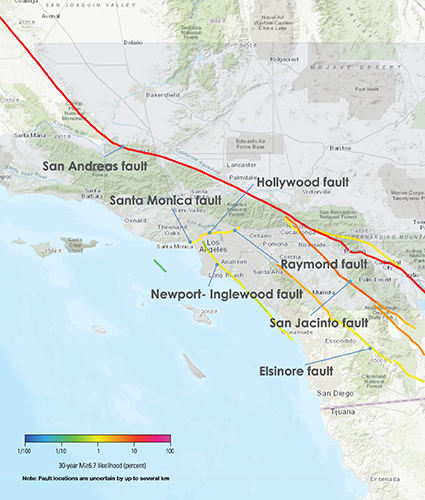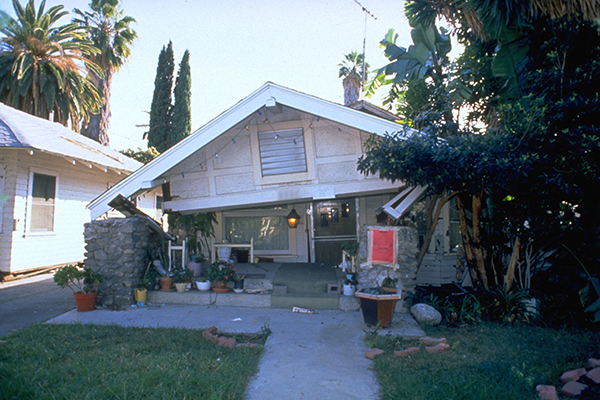This blog discusses these main topics:
- What is the risk of an earthquake in Los Angeles
- What is the probability of a large earthquake striking Southern California?
- Los Angeles earthquake prediction
- Effects & damage of a major Los Angeles earthquake
- Los Angeles earthquake risk map
- Los Angeles fault line map
- What faults are in the Los Angeles area?
- How to mitigate earthquake damage in LA
Assessing Los Angeles Earthquake Risk
When most of us on the West Coast think about Los Angeles earthquakes, we think of the Southern San Andreas fault. The San Andreas formed about 30 million years ago as the North American plate swallowed nearly all of the Farallon plate. Ever since, the North American plate has ground against the Pacific plate at a boundary called a strike-slip fault.
The Southern San Andreas fault is the longest fault in California, slicing through Los Angeles County along the north side of the San Gabriel Mountains. It can cause powerful earthquakes—as big as magnitude 8. There is 75% probability of one or more magnitude 7.0 or greater earthquakes striking Southern California, based on a 30-year period, beginning in 2014.
Los Angeles earthquakes also happen on quiet faults. The 2019 Ridgecrest earthquakes were California's biggest in more than 20 years. On Thursday, July 4th, at 10:33 a.m. PST a magnitude 6.4 earthquake struck about 12 kilometers (10.5 miles) southwest of Searles Valley. Multiple aftershocks followed, and on Friday, July 5th, another earthquake struck with a magnitude of 7.1.
The July 5, 2019 magnitude 7.1 earthquake that ruptured the earth in the Mojave Desert unleashed the power of 45 nuclear bombs. Find out more about recent Southern California earthquakes.
Los Angeles earthquake prediction
Many people in LA County feel shaking from earthquakes a couple times a year, most mild or moderate with little damage. But on average, a quake of magnitude 6.0 or larger is likely to hit somewhere in Southern California every few years. No one can predict when a big earthquake will happen. USGS has estimated that there is a Los Angeles earthquake probability of a 75% likelihood of one or more magnitude 7.5 or greater quakes striking in the next thirty years, as of 2014.
Seismologist Lucy Jones says the outcome will be worse if it happens on faults in metropolitan areas, such as Hollywood. The region has faults that run through areas with thousands of buildings and millions of people.
Earthquake damage would include destroyed freeways because Interstate 10 crosses the San Andreas in a dozen places; fires from broken gas lines; damage to the water supply; and disruption to interstate high-voltage power lines through the Cajon Pass. Electricity in Southern California could be out for days.
CoreLogic estimates that a major Southern San Andreas Fault rupture will cause 3.5 million homes to be at risk with $289 billion in reconstruction value.
Follow this computer simulation "San Andreas Earthquake Scenario" to view a 186-mile rupture from Bombay Beach to Lake Hughes.
Effects & damage of a major Los Angeles earthquake
It is possible that when the next Los Angeles earthquake strikes, 270,000 people could be displaced.
According to a USGS ShakeOut scenario, a major earthquake could cause:
- 1,800 deaths
- 1,600 fires
- 750 people trapped inside buildings
- 50,000 ER visits
- 19 days of search and rescue efforts

Southern San Andreas Earthquake Scenario
This portion of the San Andreas fault has been identified as the most likely source of a very large earthquake in California. In this computer simulation constructed through a collaborative effort between the United States Geological Survey and the Southern California Earthquake Center, the magnitude 7.8 scenario earthquake ruptures 186 miles from Bombay Beach at the edge of the Salton Sea in the south to Lake Hughes northwest of Palmdale in the north.
Beyond Magnitude: Unveiling the Widespread Impact of the 7.1 Ridgecrest Earthquake
The Ridgecrest earthquakes that hit on July 4 and July 5, 2019 with a magnitude 6.4 and 7.1, respectively, were the most recent major earthquakes in Southern California. The second quake with a magnitude 7.1 lasted 12 seconds and was felt by about 30 million people from Sacramento to San Diego. More than 6,000 homes lost power.
The Ridgecrest earthquakes followed a 25-year "quiet period" after Northridge. Northridge at a 6.7 magnitude earthquake killed 58 people, injured more than 9,000 and caused more than $49 billion in economic loss.
Long after the life-threatening phase of a quake is over, you might suffer far greater long term economic disaster as you repair or rebuild your home, experience power outages, and the central business districts are shut down.
Los Angeles Earthquake Risk Map with Fault Lines
In the metropolitan Los Angeles area, every type of fault is present. This includes blind thrust faults, like the quake along the Raymond fault that destroyed homes in Northridge in 1994. More than 4.5 million living in San Bernardino-Ontario and 10 million people in Los Angeles County are living near active or passive faults.
Find out about your home’s earthquake risk with CEA’s earthquake fault map by county.
The San Andreas Fault
The San Andreas Fault runs along the coast of California from Humboldt County in the north down to Imperial County near the Mexico border. The fault runs through high populous areas such as the San Francisco Bay Area and the Greater Los Angeles Area.
Located 30 miles from downtown Los Angeles, the Southern San Andreas fault could produce a magnitude 7 earthquake or greater that would heavily shake the nation’s second largest city.
USGS scenarios project more than 1,800 deaths, 50,000 injuries, and $200 billion in damage to homes, buildings and roads. Disruptions in water, electricity and communications could last weeks.
The San Andreas fault system consists of many parallel and active fault strands with variable rates of motion. In Southern California, the main strands are the Southern San Andreas fault, the San Jacinto fault, and the Elsinore fault.
Notable Faults in Los Angeles
Los Angeles earthquake risk encompasses of over one hundred active faults that are ready to slip.
The San Andreas Fault system consists of many parallel, active fault strands with changeable rates of motion. In Southern California, the main strands are the Southern San Andreas Fault, the San Jacinto Fault, and the Elsinore Fault.
There Are More Than 100 Active Faults in the Los Angeles Region
There are over a hundred smaller active faults in the Los Angeles region that can cause damaging earthquakes like the Northridge earthquake in 1994, along the Raymond fault. Earthquake faults are huge cracks in the earth's surface that form a borderline between shifting tectonic plates. Learn more about major faults, capable of causing extensive ground shaking:
- Elsinore fault: The Elsinore fault extends for approximately 180 km through Southern California. Despite its size, it is one of the quietest faults in the region, often called the sleeping giant.
- San Jacinto fault: A strand of the strike strip zone of the Southern San Andreas fault, scientists consider the San Jacinto fault to be one of the most seismically active faults in the SoCal area. It runs through San Bernardino, Riverside, San Diego, and Imperial Counties.
- Raymond fault: The Raymond fault travels from northeast L.A. through South Pasadena, Pasadena, San Marino, Arcadia, Monrovia and East Pasadena. For sections, the fault continues alongside Eagle Rock, York and Huntington boulevards, and under the 110 Freeway in South Pasadena.
- Santa Monica fault: The Santa Monica fault zone runs directly underneath Rodeo Drive and Beverly Hills shopping districts. The fault zone slices through the Westside, spanning Santa Monica Boulevard through Century City and Westwood before turning west, with sections intersecting Brentwood, Santa Monica and Pacific Palisades.
- Hollywood fault: The 9-mile Hollywood fault is located on the northern corner of Los Angeles. The Hollywood fault system, which includes the Malibu Coast and Santa Monica, is considered by geologists to be part of the Raymond fault.
- Newport-Inglewood fault: The 47-mile fault runs from Culver City southeast through Inglewood to& Newport Beach. The fault extends east-southeast into the Pacific Ocean becoming the Rose Canyon Fault in San Diego County.
How to mitigate earthquake damage in LA
The shaking from a major earthquake can move almost everything inside your home. Think about what could be thrown around or tipped over.
According to a UCLA study, the majority of the injuries from the damaging 1994 Northridge earthquake were from heavy furniture and household objects falling on people.
To be truly prepared for next earthquake, evaluate the safety of your home. Your home safety review ranks high on your earthquake preparation checklist, after preparing your earthquake safety kit and gathering essential supplies. Keep your family safe and prevent the injury of your loved ones by being prepared.
Watch this educational video for the best way to make your home safe.
Know What to Do During an Earthquake
An earthquake is a sudden, rapid shaking of the earth caused by the shifting of rock beneath the earth’s surface. Earthquakes strike without warning, at any time of year, day or night.
Prepare now for your family’s safety and recovery from a devastating earthquake. Create an earthquake safety plan. Practice Drop, Cover, and Hold On.
The 2019 Ridgecrest earthquakes that hit Southern California were felt as far away as Las Vegas and Arizona. The 7.1 and 6.4 quakes were the largest to strike in twenty years.
Learn about earthquake survival tips to keep your family prepared before the next big one hits.
Understand Geologic & Structural Risks to Your House
Whether it is the giant San Andreas or sleeper segment of the San Jacinto Fault, earthquake shaking will cause great devastation for the Los Angeles community.
Learn about the potential geologic threats to your home in case of a major earthquake by learning your Los Angeles earthquake risk.
The violent shaking from earthquakes can rupture the earth, trigger landslides and turn the surface of the earth to liquid. If your home was built before 1980 it may be vulnerable to serious structural damage.
Purchase Affordable Coverage
CEA earthquake insurance is easy to buy. Contact your home insurance agent to discuss adding a separate earthquake policy to your home or renter’s insurance. You can add the coverage today, no need to wait until your home policy comes up for renewal.
For the best choice of CEA earthquake insurance policies, select deductibles from 5%-25%.CEA works with residential insurance companies that serve the majority of California homeowners.
Is earthquake insurance worth it in Los Angeles?
Are you ready for the big one? Consider the following facts when, not if, a large Los Angeles earthquake hits:
- Earthquakes can cause extensive damage to the foundation, siding and roof of homes. Older homes built before 1980 on a raised foundation are especially vulnerable if they are not retrofitted.
- Without residential earthquake insurance you will be responsible for all repair and/or rebuilding costs.
- Government disaster assistance, if available, may only come in the form of a small grant or capped loan, which may cover only a portion of your repair costs and may need to be repaid.
- Without Loss of Use earthquake coverage—which includes covering your additional expenses of living elsewhere due to earthquake damage—you’d still be paying your mortgage plus temporary housing rent during the time repairs are underway.
CEA’s affordable earthquake insurance policies let you select the coverage that fits your budget. Our insurance rates, based on the latest science and research, are determined by several factors including your home’s age, location near a fault, foundation type, construction type, and roof type.
Discover the peace of mind with the smart financial decision to buy earthquake insurance in Los Angeles.


